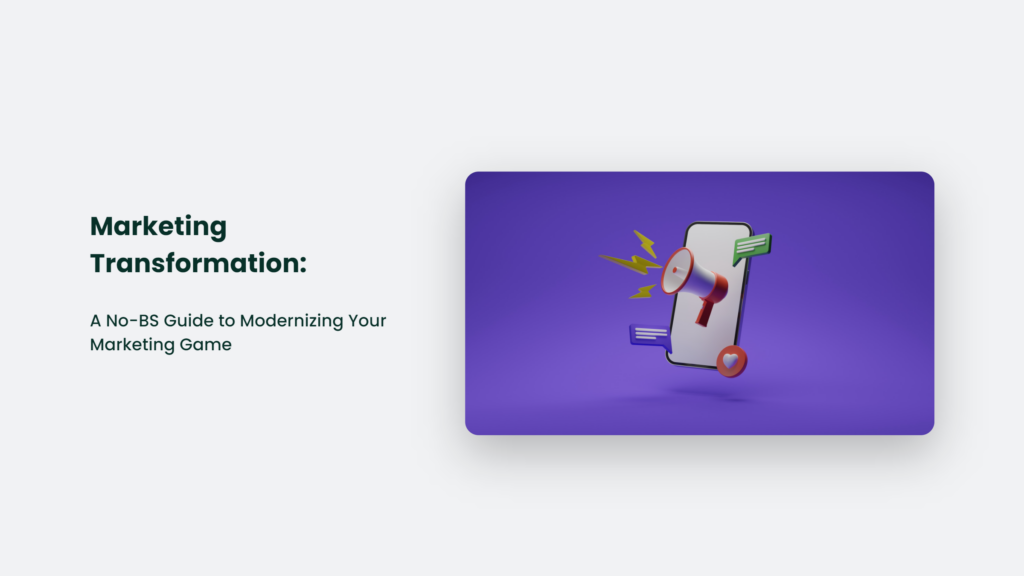

Marketing Transformation: A No-BS Guide to Modernizing Your Marketing Game

As Seen On
Ah, marketing transformation – the buzzword that’s been making the rounds in the marketing world. You might have heard it in boardrooms or brainstorming sessions, and it’s probably made you wonder: what the hell does it actually mean?
Well, fear not, dear reader, for in this no-nonsense, straight-to-the-point, and slightly irreverent article, we will demystify the living daylights out of it. So, buckle up, buttercup – it will be one hell of a ride.

From Mad Men to Math Men: The Evolution of Marketing
Let’s rewind the clock and look at how marketing has evolved over the years. Back in the day, marketing was all about slick pitches, snazzy suits, and martini lunches – it was a smoky, sexy, and somewhat sleazy world where success was measured by your ability to sell ice to an Eskimo.
But then, something happened. The digital revolution swooped in, kicked down the door, and slapped the martini glass out of Don Draper’s hand. Now, marketing is all about data, analytics, and, as one wit once put it, “algorithm-generated cat videos.” You could say that marketing has gone from being about Mad Men to being about Math Men.
Fact Bomb: The Meteoric Rise of Digital Marketing
In case you need some data to back up my ramblings, here are a few impressive numbers to chew on:
- Global digital ad spending is expected to reach $389 billion in 2023, accounting for 65% of total media ad spending (source: eMarketer).
- 50% of brands use data-driven marketing strategies (source: Forbes).
- Content marketing generates three times more leads than traditional marketing methods (source: Demand Metric).
Now that we’ve established that marketing has evolved let’s dive into what marketing transformation really is.
Marketing Transformation: The Ultimate Marketing Metamorphosis
Marketing transformation is like the marketing world’s answer to a Marvel superhero origin story – it’s about reinventing and adapting to survive in a world where traditional marketing methods are about as useful as a chocolate teapot.
But what does it entail, exactly? Here are the key components of marketing transformation:
- Digital-first approach: Embracing digital channels, tools, and technology to engage with customers and drive business growth.
- Customer-centricity: Focusing on understanding and meeting your customer’s needs rather than just pushing products or services.
- Data-driven decision-making: Using data and analytics to inform your marketing strategies and tactics and to measure their effectiveness.
- Agile marketing: Adopting flexible, iterative approaches allowing you to quickly adapt and respond to market changes.
- Collaboration and integration: Breaking down silos between departments and fostering a culture of collaboration and knowledge-sharing.
The Digital First Approach: A Tale of Two Companies
Let me hit you with a hypothetical question: Company A and Company B sell widgets. Company A has a slick website, a killer social media presence, and a savvy email marketing campaign.
Company B relies on traditional advertising methods like print ads and billboards. Which company do you think is going to win the Widget Wars?
If you guessed Company A, give yourself a pat on the back. The digital-first approach is all about using the latest digital channels and tools to engage with your customers, build your brand, and drive sales.
And the numbers don’t lie – companies that have embraced digital marketing are seeing serious results. According to a report by Adobe, digital-first companies are 64% more likely to achieve their business goals than their less digitally-savvy counterparts.
Customer-Centricity: The Heart of Marketing Transformation
Remember that old saying, “The customer is always right”? Well, in the world of marketing transformation, it’s more like “the customer is the centre of the freaking universe.” Customer-centricity is all about understanding and meeting your customer’s needs rather than just pushing products or services on them.
For example, let’s say you run a pizza delivery service. Instead of just bombarding your customers with ads about how amazing your pizza is, you could use customer data to create personalized offers based on their preferences or develop a user-friendly app that makes ordering their favourite pie easy with a few taps of their fingers.
Focusing on the customer experience makes you more likely to build long-lasting relationships and drive repeat business.
Data-Driven Decision-Making: Because Numbers Don’t Lie
Gone are the days when marketers relied on gut instinct and educated guesses to make decisions. In the era of marketing transformation, it’s all about using data and analytics to inform your strategies and tactics and to measure their effectiveness.
For instance, let’s say you’re running a social media campaign to promote your latest product. By analyzing user engagement, click-through rates, and conversion rates, you can fine-tune your campaign to target the right audience, create more compelling content, and, ultimately, drive more sales.
Power Quote: “Without data, you’re just another person with an opinion.” – W. Edwards Deming
Agile Marketing: The Art of Rolling with the Punches
If there’s one thing that’s constant in the marketing world, it’s change. And if you want to thrive in this ever-evolving landscape, you need to be able to adapt and respond to changes quickly. That’s where agile marketing comes in.
In a nutshell, agile marketing is about adopting flexible, iterative approaches that allow you to test, learn, and adapt your strategies on the fly. It’s the marketing equivalent of Bruce Lee’s famous quote: “Be like water, my friend.
Collaboration and Integration: Breaking Down the Silos
In many organizations, marketing is often siloed from other departments like sales, customer service, and product development. But in the world of marketing transformation, collaboration and integration are critical.
By breaking down these barriers and fostering a culture of knowledge-sharing and teamwork, you can ensure that your marketing efforts are aligned with your overall business goals and create a more seamless customer experience.
The Marketing Transformation Journey: It’s Not a Sprint, It’s a Marathon
So, how do you go about transforming your marketing game? Well, it’s not a one-and-done deal – it’s an ongoing process that requires commitment, experimentation, and adaptation. Here are a few steps to help you get started:
- Audit your current marketing efforts: Look hard at what’s working, what’s not, and what needs to change.
- Invest in the right tools and technology: From marketing automation platforms to data analytics tools, make sure you have the tech you need to succeed.
- Build a data-driven culture: Encourage your team to use data and insights to inform their decision-making and foster a culture of curiosity and experimentation.
- Focus on the customer experience: Make it your mission to understand and meet your customers’ needs at every touchpoint.
- Stay agile and adaptable: Be prepared to pivot and change course as needed, and don’t be afraid to take risks and try new things.
Frequently Asked Questions:
What is marketing transformation?
Marketing transformation is the process of modernizing and adapting your marketing strategies, tactics, and tools to thrive in today’s digital, customer-centric, and data-driven landscape. It involves embracing digital channels, focusing on customer needs, making data-driven decisions, adopting agile methodologies, and fostering collaboration and integration within your organization.
Why is marketing transformation important?
With the rapid evolution of technology, consumer behavior, and market dynamics, traditional marketing methods are becoming less effective. Marketing transformation is essential for businesses to stay competitive, drive growth, and build strong, long-lasting relationships with their customers.
How can my business start the marketing transformation process?
Begin by auditing your current marketing efforts to identify areas for improvement, investing in the right tools and technology, building a data-driven culture, focusing on the customer experience, and staying agile and adaptable in your strategies and tactics.
How long does marketing transformation take?
Marketing transformation is not a one-time project; it’s an ongoing process that requires continuous effort, adaptation, and learning. The timeline will vary depending on your organization’s size, resources, and goals, but it’s crucial to approach it as a long-term journey rather than a quick fix.
The Future of Marketing: Embrace the Transformation or Get Left Behind
In conclusion, marketing transformation is the key to success in the modern marketing landscape. It’s not just a fad or a fancy buzzword; it’s a fundamental shift in how businesses approach marketing and engage with customers. By embracing this transformation, you can stay ahead of the curve, drive growth, and leave your competition in the dust.
So, dear reader, are you ready to embrace the marketing metamorphosis and become the marketing superhero your business deserves? Or will you cling to outdated methods and risk becoming as relevant as a VHS tape in a Netflix world? The choice is yours – but remember, with great power comes great responsibility. And with marketing transformation comes the power to truly connect with your customers and impact their lives. Choose wisely.
Now, transform your marketing game, my friends – the future awaits.
Konger
Up until working with Casey, we had only had poor to mediocre experiences outsourcing work to agencies. Casey & the team at CJ&CO are the exception to the rule.
Communication was beyond great, his understanding of our vision was phenomenal, and instead of needing babysitting like the other agencies we worked with, he was not only completely dependable but also gave us sound suggestions on how to get better results, at the risk of us not needing him for the initial job we requested (absolute gem).
This has truly been the first time we worked with someone outside of our business that quickly grasped our vision, and that I could completely forget about and would still deliver above expectations.
I honestly can't wait to work in many more projects together!
Disclaimer
*The information this blog provides is for general informational purposes only and is not intended as financial or professional advice. The information may not reflect current developments and may be changed or updated without notice. Any opinions expressed on this blog are the author’s own and do not necessarily reflect the views of the author’s employer or any other organization. You should not act or rely on any information contained in this blog without first seeking the advice of a professional. No representation or warranty, express or implied, is made as to the accuracy or completeness of the information contained in this blog. The author and affiliated parties assume no liability for any errors or omissions.

